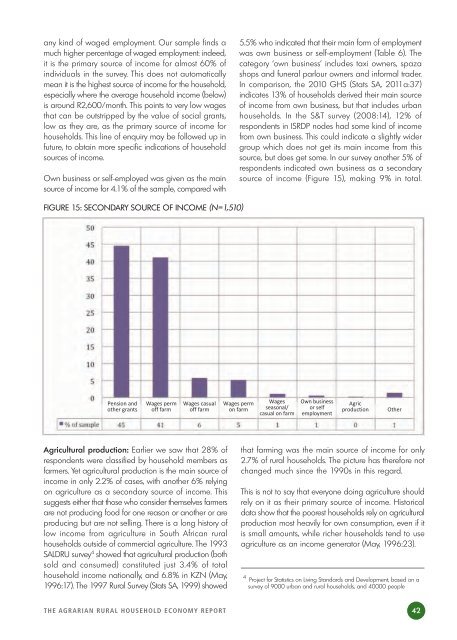THE AGRARIAN RURAL HOUSEHOLD ECONOMY
THE AGRARIAN RURAL HOUSEHOLD ECONOMY
THE AGRARIAN RURAL HOUSEHOLD ECONOMY
You also want an ePaper? Increase the reach of your titles
YUMPU automatically turns print PDFs into web optimized ePapers that Google loves.
any kind of waged employment. Our sample finds a<br />
much higher percentage of waged employment: indeed,<br />
it is the primary source of income for almost 60% of<br />
individuals in the survey. This does not automatically<br />
mean it is the highest source of income for the household,<br />
especially where the average household income (below)<br />
is around R2,600/month. This points to very low wages<br />
that can be outstripped by the value of social grants,<br />
low as they are, as the primary source of income for<br />
households. This line of enquiry may be followed up in<br />
future, to obtain more specific indications of household<br />
sources of income.<br />
Own business or self-employed was given as the main<br />
source of income for 4.1% of the sample, compared with<br />
FIGURE 15: SECONDARY SOURCE OF INCOME (N=1,510)<br />
Pension and<br />
other grants<br />
Wages perm<br />
off farm<br />
Wages casual<br />
off farm<br />
Agricultural production: Earlier we saw that 28% of<br />
respondents were classified by household members as<br />
farmers. Yet agricultural production is the main source of<br />
income in only 2.2% of cases, with another 6% relying<br />
on agriculture as a secondary source of income. This<br />
suggests either that those who consider themselves farmers<br />
are not producing food for one reason or another or are<br />
producing but are not selling. There is a long history of<br />
low income from agriculture in South African rural<br />
households outside of commercial agriculture. The 1993<br />
SALDRU survey 4 showed that agricultural production (both<br />
sold and consumed) constituted just 3.4% of total<br />
household income nationally, and 6.8% in KZN (May,<br />
1996:17). The 1997 Rural Survey (Stats SA, 1999) showed<br />
<strong>THE</strong> <strong>AGRARIAN</strong> <strong>RURAL</strong> <strong>HOUSEHOLD</strong> <strong>ECONOMY</strong> REPORT<br />
5.5% who indicated that their main form of employment<br />
was own business or self-employment (Table 6). The<br />
category ‘own business’ includes taxi owners, spaza<br />
shops and funeral parlour owners and informal trader.<br />
In comparison, the 2010 GHS (Stats SA, 2011a:37)<br />
indicates 13% of households derived their main source<br />
of income from own business, but that includes urban<br />
households. In the S&T survey (2008:14), 12% of<br />
respondents in ISRDP nodes had some kind of income<br />
from own business. This could indicate a slightly wider<br />
group which does not get its main income from this<br />
source, but does get some. In our survey another 5% of<br />
respondents indicated own business as a secondary<br />
source of income (Figure 15), making 9% in total.<br />
Wages perm<br />
on farm<br />
Wages<br />
seasonal/<br />
casual on farm<br />
Own business<br />
or self<br />
employment<br />
Agric<br />
production Other<br />
that farming was the main source of income for only<br />
2.7% of rural households. The picture has therefore not<br />
changed much since the 1990s in this regard. .<br />
This is not to say that everyone doing agriculture should<br />
rely on it as their primary source of income. Historical<br />
data show that the poorest households rely on agricultural<br />
production most heavily for own consumption, even if it<br />
is small amounts, while richer households tend to use<br />
agriculture as an income generator (May, 1996:23). .<br />
4 Project for Statistics on Living Standards and Development, based on a<br />
survey of 9000 urban and rural households, and 40000 people<br />
42


